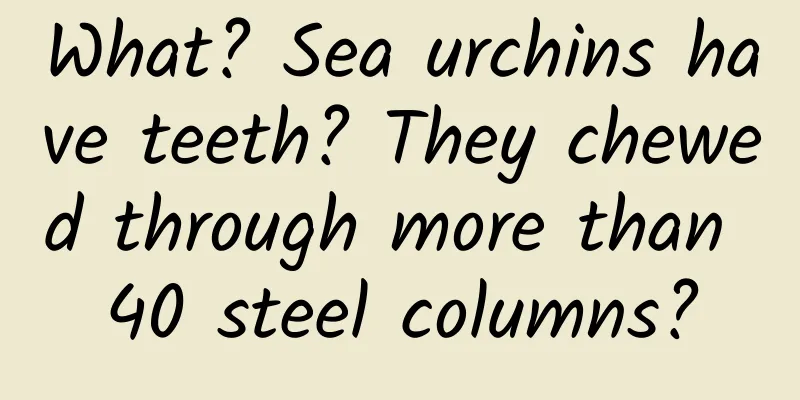What? Sea urchins have teeth? They chewed through more than 40 steel columns?

|
In 1953, an astonishing report appeared: in California, USA, half of the more than 40 steel columns of a breakwater were destroyed; this may not be a big deal, but the murderer that destroyed these steel columns was actually sea urchins. Moreover, the report was not published by some eye-catching tabloid, but by the crown of scientific research - Science. Sea urchin: Actually, it’s me who’s the sea urchin! | Pixabay "Eating" steel and stone ✦ Sea urchins have very good teeth. They eat the algae on the surface of the rocks, and eventually they will eat holes in the rock surface. The holes are also useful. The sea urchins tuck themselves in to avoid being washed away by the waves. After the steel column was put into the sea, sea urchins gnawed away the oxide layer on the surface, exposing the metal to the corrosion of seawater. Rust continued to corrode the inside, and the steel column became bumpy (some pits were even 1 cm deep), and finally it was scrapped. How powerful are sea urchins' teeth? A team led by Michael P. Russell from Villanova University designed an experiment. They kept sea urchins in small cages and placed a stone inside. After half a year and a year, they measured the dents and weight loss on the stone. The results showed that sea urchins are quite good at biting: for medium-coarse sandstone, they can bite 32 grams per year. Sea urchins in small cages | Michael P. Russell et al. / PLoS One (2018) The team also observed sea urchins in the wild: within a year, sea urchins in the wild can chew out visible depressions in sandstone. In this way, within five years, the sea urchins can dig a hole large enough for them to drill into. However, granite is much harder, and sea urchins cannot dig a hole large enough to accommodate themselves in a hundred years (of course, sea urchins cannot live that long, but the next generation of sea urchins may inherit the old pit and continue digging). According to their estimates, all sea urchins on a hectare of coast will chew up 200 tons of stone each year, which is no less than the amount of sediment in some rivers. A coast pitted by sea urchins | Michael P. Russell et al. / PLoS One (2018) The most amazing animal teeth ✦ The next question is, what do sea urchins use to chew rocks? The mouth of a sea urchin is the most peculiar in the animal world. Its mouthparts are hidden inside the body, with a complex structure and a lantern-like shape. Aristotle was the first person in the Western world to describe it, hence the name Aristotle's lantern. The mouthparts of a sea urchin have five jaws inside, each with a tooth on the inner wall. The five teeth form a plum blossom shape and can be opened and closed like the claws of a claw machine. The sea urchin uses this "claw" to dig algae on the rocks. Teeth of the purple sea urchin Strongylocentrotus purpuratus | Wilson44691 / Wikimedia Commons The Jacobs School of Engineering at the University of California has studied many bionics projects. Researchers have used 3D microscopy to analyze the structure of sea urchin mouthparts and imitated their structure to make mechanical claws for digging. The shape of sea urchin teeth can reduce pressure, and they hope that this mechanical claw can be applied to the Mars rover to grab sand samples. A robotic claw that mimics sea urchin teeth | JacobsSchoolNews The teeth of sea urchins are the most delicate part of the entire mouthparts. They are long and narrow, but the cross section is T-shaped, and are composed of magnesium-containing calcite crystals. Due to the different magnesium content, the strength of different parts of the teeth is also different, and the hardness and toughness of the center are the highest. The calcite crystals inside the teeth have two forms: slender fibers and curved thin plates. The outer layer is wrapped with weaker organic matter. The two crystals are intertwined to form a solid whole. Sea urchins have complex mouthparts, long T-shaped teeth, and layers of mineral crystals inside | H. Espinosa et al. / Materials Science (2019) Although sea urchin teeth are hard, there is still a problem that has not been solved: if they are constantly rubbed against hard objects, the blade will inevitably become dull. Will the teeth also be worn out after being rubbed for a long time? This shows the ingenuity of the internal structure of sea urchin teeth - when sea urchins bite hard objects, their teeth break off from the softer organic layer, just like breaking open a sandwich cookie. Therefore, the calcite crystals do not slowly smooth out the edges, but break off piece by piece, allowing the teeth to always remain thin and sharp. In addition, the inner core of the sea urchin tooth is the hardest and wears the slowest, while the outer layer wears more, which also makes the teeth thinner and thinner, but they can always maintain a sharp "blade" state. Of course, sea urchins have more than just their ferocious fangs. These thorny balls also have a pretty cute side. Three years ago, the Kanagawa Fisheries Technology Center fed sea urchins with cabbage leaves discarded by local agriculture. Their original intention was to fatten up delicious seafood and reduce the waste of cabbage leaves; but unexpectedly, the sight of a group of sea urchins gnawing on the vegetables was too funny, and they became popular on the Internet, and some people even made cute sea urchin toys. After all, sea urchins look so silly, and most people would never have thought that they have "iron teeth and copper teeth". References [1] Espinosa HD, Zaheri A, Nguyen H, et al. In situ wear study reveals role of microstructure on self-sharpening mechanism in sea urchin teeth[J]. Matter, 2019, 1(5): 1246-1261. [2] Irwin, Margaret Constance. "Sea urchins damage steel piling." Science 118.3063 (1953): 307-307. [3] Russell, Michael P., Victoria K. Gibbs, and Emily Duwan. "Bioerosion by pit-forming, temperate-reef sea urchins: History, rates and broader implications." PLoS One 13.2 (2018): e0191278. [4] Ma Yurong. "Study on biomineralization of sea urchin teeth." Abstracts of the 13th session of the 27th Annual Conference of the Chinese Chemical Society (2010). Author: Little Wombat Editor: pee pee shrimp This article comes from the Species Calendar, welcome to forward If you need to reprint, please contact [email protected] |
<<: Leeks, cut and grown again, are a favorite on Chinese tables
>>: What is the core of what Liu Genghong said? Don’t wait until you get hurt to understand!
Recommend
The ultimate goal of palace fighting: to undergo sex change and become emperor!
There are many problems in the world that come fr...
How to improve the community’s operational processes and refine its operations?
Community operation is a very complex job, even m...
5 strategies for social media marketing!
Introduction: There is a vast world for social tr...
The latest WeChat 8.0.15 version update adds four major changes
Coinciding with the National Day holiday, the off...
Qualcomm: Android phone users will be able to use face recognition next year
According to 9To5Mac on August 15 Beijing time, t...
In-depth understanding of Android Studio Sync process
1. Getting to know Sync We generally understand S...
315 is here! Don’t turn crisis PR into a PR crisis!
The annual 315 Gala is coming soon, and for many ...
Science Time Machine | How was Uranus discovered?
Uranus is the first planet in human history to be...
Can toilet paper be flushed directly down the toilet after using it? Let me show you how
When you walk into a public toilet cubicle, you w...
The sales of these 6 Korean SUVs have been pushed into a desperate situation.
In the automobile market, SUV is "undoubtedl...
Enterprise IP Marketing Operation Guide
What IP can create for enterprises is not just a ...
Tik Tok promotion strategy, how to come up with a Tik Tok title?
Tik Tok is a popular product. Many individuals, t...
Why do we still need POS machines when mobile payment is on the rise?
Apple Pay was launched in November last year, spa...
This little blue bird sends flowers to the opposite sex all year round
The Malurus splendens is a small bird endemic to ...
When learning to cook, the beasts are not afraid of burning the bottom of the pot, but are afraid of scalding themselves! Get these first aid skills
Starting from September this year, the Ministry o...

![[Exclusive] DY Empowerment System Star Course](/upload/images/67cc0c77b8079.webp)







